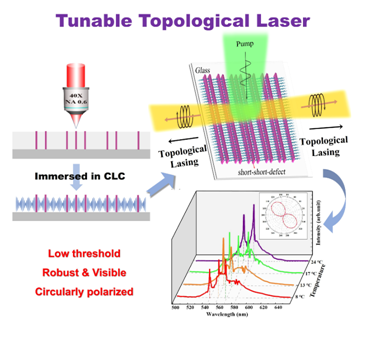In recent years, the flexible and effective manipulation of light has become the core problem of the development of information industrial technology with photon as the carrier. Topological physics has brought a new degree of freedom into photonics, pioneering the development of the emerging research field of topological photonics. Topologically protected edge states offered a brand new channel to realize the locally enhanced optical modes to conspicuously improve the output quality of laser while being able to be immune to disorders resulting from the manufacture error and some structure defects. However, such a character has also led to the inflexible adjustment of topological laser wavelength. On the other hand, lasers at visible region are of great significance for various fields, such as display, sensing, processing and quantum information. However, limited to the spatial resolution of current processing technologies, most of the designed topological lasers are based on photonic structures of characteristic size on the micrometer scale, with lasing wavelengths at the infrared wavelength region. It still remains a challenge to fabricate topological structures for lasing in visible spectral region with high performance, especially when the tunability and controlled polarization characteristics are also desired. This brings about a question: Is it possible to employ natural materials exhibiting photonic bandgaps to realize low-cost tunable topological lasers?
Recently, a research group led by professor Zhang Xinzheng, Chen Zhigang and Xu Jingjun from the School of Physics and TEDA Institute of Applied Physics, Nankai University, published their latest achievements in the field of topological laser on Laser & Photonics Reviews, titled as Tunable Topological Lasing of Circularly Polarized Light in a Soft-matter-based Superlattice. The group designed superlattice based on cholesteric liquid crystal and laser active polymer to realize the first time tunable and visible topological laser in a soft-matter-based superlattice.
Polymer ribbons formed one-dimensional structure with micron-sized period based on the SSH model and contained a topological defect at the interface between topologically trivial and non-trivial sub-structures. When the polymer structure is immersed into a cholesteric liquid crystal, the polymer ribbons can be considered as defect layers, thus forming mini-bands in the visible photonic band gap of the cholesteric liquid crystal. This design of superlattice belongs to the type of one-dimensional coupling arrays. By adjusting the distribution of strong and weak coupling between neighbouring polymer ribbons, the topological properties of all mini-bands can be manipulated to further realize topological phase transition through the inversion of mini-bands. In this way, non-trivial topological interface states appear in all mini-bandgaps, bringing about possibilities to realize the tunability of laser wavelength. With the use of the femtosecond laser direct writing techniques and the out-of-plane compartmentalized alignment technology of liquid crystal independently developed by the research group (obtained the authorization of national invention patent and the international invention patent), it is able to prepare polymer - cholesteric liquid crystal superlattice doped with laser dye at low costs, thus realizing visible topological interface lasing of circular polarization under the pump of nanosecond pulsed laser. It also demonstrated that the lasing threshold (0.4 mJ) is significantly lower than that of the topologically trivial defect state lasing in the same superlattice. Furthermore, the thermal tuning of laser wavelength is achieved based on the thermo-optic effect of cholesteric liquid crystal and it is demonstrated that the topological laser wavelength is robust to experimental manufacture errors and chiral perturbations. The work provides prospects for low-cost implementation of tunable, circularly polarized, compact integrated topological photonic devices, and offers an ideal platform for exploring the topological physics of light-matter interactions in soft matter environments.

Figure 1 Diagram of the Realization of Tunable Topological Lasing Based on the Polymer Cholesteric Liquid Crystal Superlattice Reported in the Paper
Nankai University is the first affiliation of the paper. Wang Yu and Yang Donghao, Ph.D. students of Nankai University, and Gao Shaohua, visiting scholar of Taiyuan University of Technology, are the co-first authors of the work, other collaborators include professor Irena Drevensek-Olenik from The University of Ljubljana, professor Wu Qiang from Nankai University and post-doctor Marouen Chemingui. In addition, with long-term cooperation with professor Irena Drevensek-Olenik, professor Zhang Xinzheng was approved with the Joint Research Laboratory (research center) of “One Belt and One Road” in Tianjin - “International Sino-Slovenian Joint Research Center on Liquid Crystal Photonics at Nankai University” in 2020. The related work has been supported by the National Key Research and Development Program and the National Natural Science Foundation.
Link of Paper: https://doi.org/10.1002/lpor.202200643



